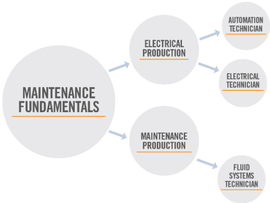TURNKEY TRAINING
for Maintenance
LEARNING PLANS FOR MANUFACTURING JOB ROLES
Turnkey Training from The Mackenzie Group offers a quick-start, progressive road map that allows manufacturers to build career paths for employees. Turnkey Training is intended to enhance your existing OJT and help you create a job progression plan. Unlike many other training programs, Turnkey Training requires minimal preparation. It is efficient, effective training that has been developed with input from manufacturing experts.
FLEXIBLE AND CONVENIENT
Online classes are self-paced, typically taking 60 minutes to complete. On average, employees can progress through a job role in one year with as little as 4 hours a month spent online
TURNKEY TRAINING OFFERS
- Predefined curriculum for each job role
- Engaging and interactive online classes
- Supplemental videos and a reinforcement task for each class
- Pre- or post-training knowledge assessments
- Access to our Learning Management System (LMS)
- Guidance from our Client Success team, including advice, insights, and ideas built on best practices and years of experience
CAREER PATHWAYS
FOR MAINTENANCE JOB ROLES
Combine job roles for learning pathways, or offer single job roles for targeted learning. Large comprehensive programs also available.

MACHINING FUNDAMENTALS
Electrical Units
Safety for Electrical Work
Basic Measurement
Basics of Tolerance
Blueprint Reading
Calibration Fundamentals
Hole Standards and Inspection
Thread Standards and Inspection
5S Overview
Lean Manufacturing Overview
Ferrous Metals
Introduction to Mechanical Properties
Introduction to Metals
Introduction to Physical Properties
Forces of Machines
Introduction to Mechanical Systems
Safety for Mechanical Work
Approaches to Maintenance
Approaches to MaintenanceISO 9001:2015 Review
Bloodborne Pathogens
Confined Spaces
Fire Safety and Prevention
Flammable/Combustible Liquids
Hand and Power Tool Safety
Intro to OSHA
Lockout/Tagout Procedures
Noise Reduction and Hearing Conservation
Personal Protective Equipment
Powered Industrial Truck Safety
Respiratory Safety
Safety for Lifting Devices
SDS and Hazard Communication
Walking and Working Surfaces
Math Fundamentals
Math: Fractions and Decimals
Units of Measurement
ELECTRICAL PRODUCTION
Control Panel Functions for the CNC Lathe
Control Panel Functions for the CNC Mill
Introduction to CNC Machines
AC Fundamentals
Conductor Selection
DC Circuit Components
Electrical Instruments
Electrical Print Reading
Introduction to Circuits
Introduction to Magnetism
NEC(R) Overview
Parallel Circuit Calculations
Series Circuit Calculations
Troubleshooting
Essentials of Heat Treatment of Steel
Lubricant FundamentalsControl Devices
Distribution Systems
Introduction to Electric Motors
Limit Switches and Proximity Sensors
Logic and Line Diagrams
Relays, Contactors, and Motor Starters
Algebra Fundamentals
Geometry: Circles and Polygons
Geometry: Lines and Angles
Geometry: Triangles
Trigonometry: Sine, Cosine, Tangent
Trigonometry: The Pythagorean Theorem
Essentials of Communication
Essentials of Leadership
Overview of Soldering
MAINTENANCE PRODUCTION
Approximately 4 hours per month
Battery Selection
Parallel Circuit Calculations
Series Circuit Calculations
Introduction to Fastener Threads
Overview of Non-Threaded Fasteners
Overview of Threaded Fasteners
Threaded Fastener Selection
Tools for Threaded Fasteners
Understanding Torque
Fittings for Fluid Systems
Introduction to Fluid Conductors
Introduction to Hydraulic Components
Introduction to Pneumatic Components
Preventive Maintenance for Fluid Systems
Safety for Hydraulics and Pneumatics
The Forces of Fluid Power
Troubleshooting
Essentials of Heat Treatment of Steel
Nonferrous Metals
Bearing Applications
Belt Drive Applications
Clutch and Brake Applications
Gear Applications
Lubricant FundamentalsMechanical Power Variables
Spring Applications
AC Motor Applications
DC Motor Applications
Distribution Systems
Introduction to Electric Motors
Logic and Line Diagrams
Reduced Voltage Starting
Reversing Motor Circuits
Solenoids
Specs for Servomotors
Symbols and Diagrams for Motors
Intro to Machine Rigging
Rigging Equipment
Rigging Inspection and Safety
Rigging Mechanics
Algebra Fundamentals
Geometry: Circles and Polygons
Geometry: Lines and Angles
Geometry: Triangles
Trigonometry: Sine, Cosine, Tangent
Trigonometry: The Pythagorean Theorem
Essentials of Communication
Essentials of Leadership
AUTOMATION TECHNICIAN
Introduction to Fastener Threads
Overview of Non-Threaded Fasteners
Overview of Threaded Fasteners
Threaded Fastener Selection
Tools for Threaded Fasteners
Understanding Torque
Fittings for Fluid Systems
Introduction to Fluid Conductors
Introduction to Hydraulic Components
Introduction to Pneumatic Components
Safety for Hydraulics and Pneumatics
The Forces of Fluid Power
Bearing Applications
Belt Drive Applications
Clutch and Brake Applications
Gear Applications
Mechanical Power Variables
Spring Applications
Basic Programming for PLCs
Basics of Ladder Logic
Data Manipulation
Hand-Held Programmers of PLCs
Hardware for PLCs
Introduction to PLCsNetworking for PLCs
Numbering Systems and Codes
Overview of PLC Registers
PID for PLCs
PLC Counters and Timers
PLC Inputs and Outputs
PLC Installation Practices
PLC Program Control Instructions
Sequencer Instructions for PLCs
Intro to Machine Rigging
Rigging Equipment
Rigging Inspection and Safety
Rigging Mechanics
Concepts of Robot Programming
End Effectors
Robot Axes
Robot Components
Robot Installations
Robot Maintenance
Robot Safety
Robot Sensors
Robot Troubleshooting
Vision Systems
ELECTRICAL TECHNICIAN
Approximately 2 hours per month
Battery Selection
Introduction to Fastener Threads
Overview of Non-Threaded Fasteners
Overview of Threaded Fasteners
Threaded Fastener Selection
Tools for Threaded Fasteners
Understanding Torque
Fittings for Fluid Systems
Introduction to Fluid Conductors
Introduction to Hydraulic Components
Introduction to Pneumatic Components
Safety for Hydraulics and Pneumatics
The Forces of Fluid Power
Nonferrous Metals
Bearing Applications
Belt Drive ApplicationsClutch and Brake Applications
Gear Applications
Mechanical Power Variables
Spring Applications
AC Motor Applications
DC Motor Applications
Distribution Systems
Reduced Voltage Starting
Reversing Motor Circuits
Solenoids
Specs for Servomotors
Symbols and Diagrams for Motors
Intro to Machine Rigging
Rigging Equipment
Rigging Inspection and Safety
Rigging Mechanics
FLUID SYSTEMS TECHNICIAN
Approximately 3 hours per month
Control Panel Functions for the CNC Lathe
Control Panel Functions for the CNC Lathe
Introduction to CNC Machines
AC Fundamentals
AC Power Sources
Conductor Selection
DC Circuit Components
DC Power Sources
Electrical Instruments
Electrical Print Reading
Introduction to Circuits
Introduction to Magnetism
NEC(R) Overview
Actuator Applications
Contamination and Filter Selection
Hydraulic Control Valves
Hydraulic Fluid Selection
Hydraulic Power Sources
Hydraulic Power Variables
Hydraulic Principles and System Design
Hydraulic Schematics and Basic Circuit DesignPneumatic Control Valves
Pneumatic Power Sources
Pneumatic Power Variables
Pneumatic Schematics and Basic Circuit Design
Benchwork and Layout Operations
Control Devices
Distribution Systems
Limit Switches and Proximity Sensors
Relays, Contactors, and Motor Starters
Electrical Safety for Welding
GMAW Applications
Introduction to Welding
Introduction to Welding Processes
Overview of Soldering
Oxyfuel Welding Applications
Plasma Cutting
PPE for Welding
SMAW Applications
Welding Fumes and Gases Safety
Welding Safety Essentials
What Is Oxyfuel Welding?

